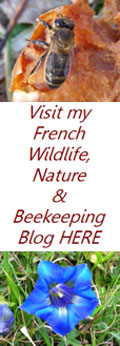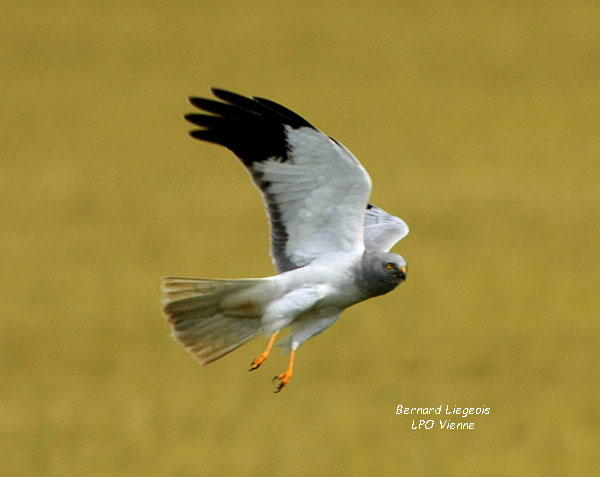

The plains of Poitou-Charentes and Vendée whether they be the high open windswept areas such as those characterises by the areas to the north west and west of Poitiers towards Thouars and Parthenay or the vast low open wetlands of the Marais poitevin and coastline are especially suited to certain birds, some of which are under severe pressure at the European and National level making our region particularly important for their continued well being.
In this article I take a look at three specific birds, all Harriers which benefit from active protection and intervention measures especially with regard to reproduction, the Hen Harrier, the Marsh Harrier and the Monatgu’s Harrier and start with a short overview of each.
Marsh Harrier, (Busard des roseaux), nesting populations in France are concentrated in the west coast Marais of Morbihan, Loire Atlantique, Vendée, Charente-Maritime and Gironde with another small concentration on the French south coastal zones of Gard and Bouches-du-Rhone. Smaller numbers can be found elsewhere perhaps more so in the wetlands of Picardie and the great lakes of Champagne-Ardennes but it is the Charente-Maritime / Gironde population that is by far the most significant. Nests are made on the ground in wetlands, reed beds and cereal fields and eggs are laid mid April – early May and as well as being targets for predators they are vulnerable to destruction by industrial reed cutting or harvesting and still to some degree human persecution. In total there are estimated to be between 1,600 and 2,200 breeding couples and their prey is mainly voles, young coypu, rabbit and rats although other small ground nesting birds and their chicks are also taken. There is a tendency for Marsh Harriers to move nearer to the south of France, Spain or even Africa for winter returning in March but this is sporadic and partial.
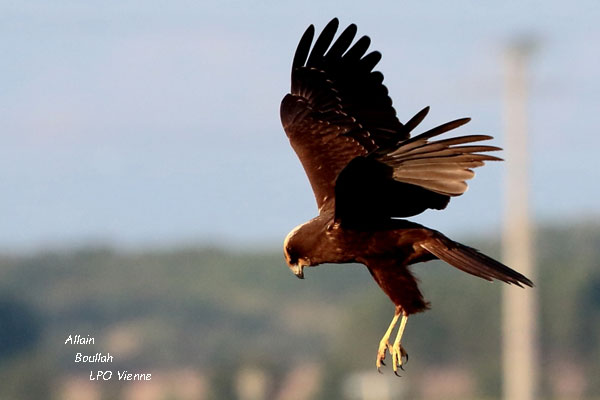
Marsh Harrier, Vienne, France - credit Allain Boullah LPO Vienne
Hen Harriers, (Busard Saint Martin), are a more widespread species of bird in France with a much wider range of potential nesting sites typically heath-land, large forest clearings and most importantly cereal fields these days as other habitats have disappeared. Unlike the Marsh and Montagu’s Harriers they tend to avoid the coastal wetlands, (marais littoraux). Nests are made on the ground in low to medium density vegetation in March or April using grasses and plant stalks where they lay 4 to 6 eggs but this may be reduced or even arrested if there is insufficient prey available in years when there is a crash in the vole population. Other prey such as Quail and Partridge are taken which often causes conflict with hunters. Poitou-Charentes and Vendée host up to 20% of the French nesting Hen Harriers, the total number for France being estimated at between 7,800 and 11,200 breeding couples. As with the Marsh Harrier there is a tendency for some to move nearer to the south of France or to Spain for winter returning in March but this is sporadic and partial.

Hen Harrier male, Vienne, France - credit Bernard Liegeois LPO Vienne
Monatagu’s Harriers, (Busard cendré), effectively nest in three main zones in France. Poitou-Charentes/Vendée, Champagne-Ardennes/Cote d’or, and the Massif Central/Roussillon. Of these Poitou-Charentes is probably the most important with the largest concentrations being in Deux-Sevres and Vienne on the cereal plains. Nests are constructed on the ground in April or May hidden in medium height vegetation using small pieces of twig and stems where 3 to 5 eggs are laid. Nests tend to be in cereal fields, (Oil seed rape, wheat or barley), and less frequently on heath or large wastelands of the type that can be found in parts of Charente-Maritime. Prey is almost exclusively voles and the total number for France is between 3,900 and 5,100 breeding couples. This is a fully migratory bird that spends the winter on the Savannahs of West Africa where they eat large insects and reptiles. They depart France in September and arrive back here in early April.

Montagu's Harrier male with Skylark, Vienne, France - credit
Bernard Liegeois LPO VienneAll three types of Harrier are easily seen as they make their slow low altitude passes over open spaces when hunting or moving to and from a hunting zone. They avoid trees and woodland at all times and roost on the ground.
Protection for the nests of Marsh Harriers is as much about preserving existing habitat as anything else although they do nest increasingly in cereal fields throughout the Poitou-Charentes and Vendée. Since 2006 the Centre d’Etudes Biologiques de Chizé (CEBC-CNRS) has had a program of wing tagging at four sites in Charente-Maritime to study their population and nesting dynamics.
Protection for the nests of Hen and Monatgu’s Harriers is somewhat more complex due in large part to changes in agricultural practices, crops grown and machinery used. In the past crops on the open plains were more diverse with wheat and barley being spring sown with the land worked using small machines or by hand. The Harriers adapted to using wheat and barley fields for nesting and then what is called the Green revolution gathered pace. Autumn sown barley and wheat crops were developed and there was the introduction of oil seed rape, also autumn sown in France. Farm machinery keeps increasing in size and crops are harvested earlier in the year which in most years will be before the chicks have fledged leading to large losses as they are chopped up where no preventative action is put in place.
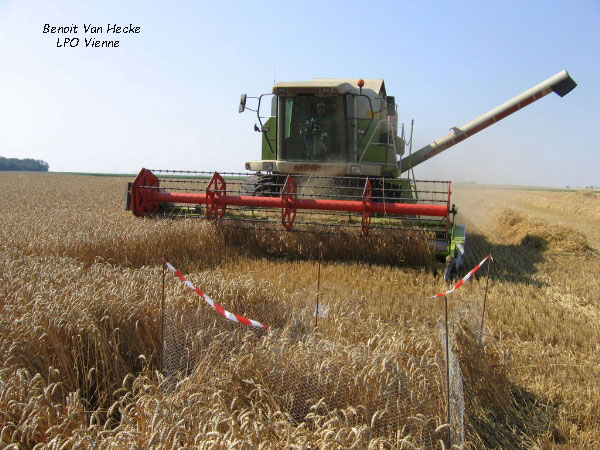
Harvester working around a protected Harier nest, Vienne, France - credit Benoit Van Hecke, LPO Vienne.
With this in mind the five ornithological associations of Poitou-Charentes and Vendée: Groupe ornithologique des Deux-Sèvres, the LPO Vienne, LPO Vendée, LPO Charente Maritime and Charente Nature participate in protection schemes that attempt to gain the support of farmers in the most important zones. This means spending many hours building relationships to convince individual farmers to agree to an active monitoring program which will include a marking of nests when identified. This can sometimes prove to be a lot harder than you may imagine with concerns about pieces of chicken wire or metal rods being left behind to damage farm machinery and of course there is still some ill feeling towards these Harriers due to them taking the occasional game bird, (mainly Partridge).
Most of the day to day work is carried out by volunteers commencing with observation of the birds in spring in the main nesting zones to record birds that are paired and then where the nest sites are located. Initially this means observing mating displays and aerial prey passing followed later by males carrying prey in their talons which they bring to near the nest site for the female. She will either fly up and the prey will be passed to her in flight or the male will place it on the ground a short distance away and she will fetch it. Having noted where she flies up from and returns to it is then possible to carefully locate the nest, mark it with poles and fix chicken wire protection against predators.
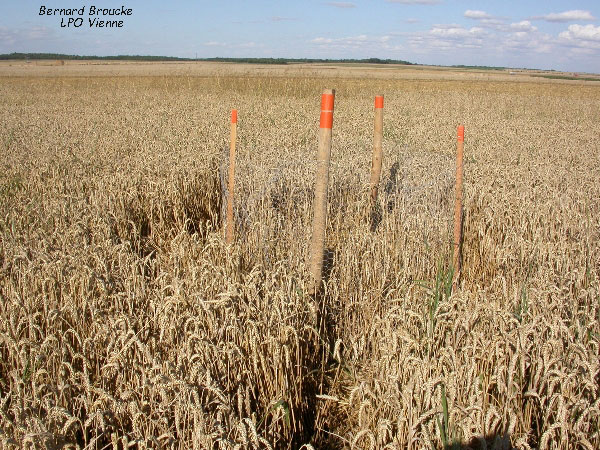
Harriers nest marked and protected, Vienne, France - credit Bernard Brouke LPO Vienne

Baby Montagu's Harriers, Vienne, France - credit Allain Boullah
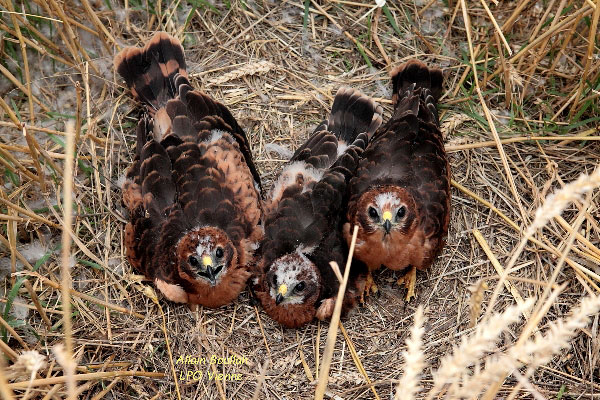
Young Montagu's Harriers, Vienne, France - credit Allain Boullah
Regular monitoring of the progress of each nest continues through to fledging and abandonment of the nest site usually around the end of July. At this time the harvest will generally be well under way if not completed and the Harriers have to find places to roost on the ground where there is a suitable density of ground cover and the occasional fields of alfalfa, (Lucerne), are excellent for this. Here the Harriers, more so the Montagu’s Harrier than the Hen Harrier, will form large communal roosts which is a wonderful sight to see as they start to drift in at dusk. This provides the perfect opportunity throughout the month of August for volunteers to simultaneously count and record the number, sex and age of the population with most importantly the number of the current years young.
As with most species there are good years and bad years, weather conditions at critical times and availability of prey can have a drastic effect on numbers and behaviour. 2013 was particularly bad due to a lack of voles and many couples didn’t even attempt to raise young, however 2014 has been excellent.
If you live or have an interest in the region you may wish to consider joining one of the Associations below where you will be able to participate in a range of activities; you don’t need to have any previous knowledge or experience.
Groupe ornithologique des Deux-Sèvres. 48 Rue Rouget de Lisle, 79000 Niort. 05 49 09 24 49
LPO Vienne. 25 rue Victor Grignard - 86000 Poitiers - 05 49 88 55 22
LPO Vendée. La Brétinière, 85000 La Roche-sur-Yon. 02 51 46 21 91
LPO Charente Maritime. 21 rue Vaugouin, 17000 La Rochelle, 05 46 50 92 21
. Impasse Lautrette, 16000 Angouleme. 05 45 91 89 70*(LPO = Ligue pour la Protection des Oiseaux).
Video in French protection of Harriers - worth watching even if you don't understand French.

